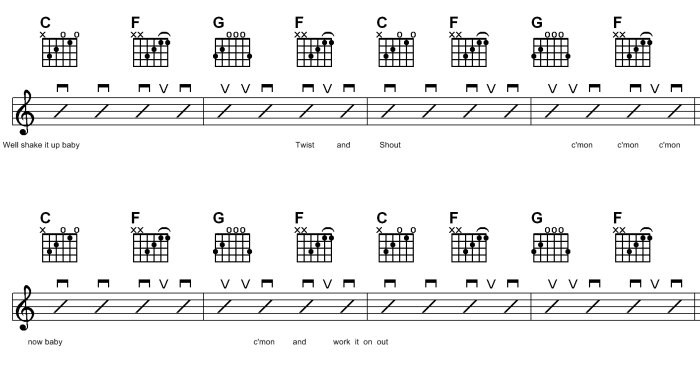Chord Inversions - F Shape
Lesson Goals:
♦ Review chord inversions
♦ Learn F shape chord inversion
♦ Use F shape to play various major chord inversions
Another chord inversion you will commonly use is based on the "F" chord shape, just like in the last lessons where we did inversions based on the D chord shape.
If you understood the last lesson (Lesson 84) then this one will be a piece of cake!
We will apply the same principles, only this time using the shape of the open or first position F chord.

Now, just like we did with the D shape inversions, we will just slide this F chord shape up the neck of the guitar to play various other chord inversions. All we have to do is remember the interval between notes (whole steps and half steps) that we learned way back toward the beginning.
In other words, if we take the F chord (as above) and slide that shape up 1 whole step (which equals 2 frets), to the 3rd fret, then we would be playing a G chord inversion.
Look at the diagram below

Notice above that by sliding the F "shape" up to the 3rd fret we are now playing a G chord inversion. Slide that up 1 more whole step (2 frets) and you are now playing an A chord inversion. Up another whole step to the 7th fret and you are now playing a B chord inversion.
Next, you may recall that the distance from B to C (whether it's single notes or chords) is always a half step (1 fret), so from the B chord inversion on the 7th fret, you just slide up 1 fret (to the 8th fret) and you are now playing a C chord inversion.
And finally, slide that up 1 whole step (2 frets) to the 10th fret and you are now playing a D chord inversion in the "F" shape.
Now let's take a look at how we can apply what we have learned in this and the previous lesson to a song that we already know.
If you will remember back to Lesson 22 we learned how to play Twist & Shout by The Beatles. In the following example we will now be able to play the same song using the chord inversions of the C, F and G chords.
Here are how the inversions of those three chords would look:

Below is the music chart that we originally used to play the song. All you need to do now is to substitute the chord inversions of the C, F and G chords for the ones we used when we first learned the song.

Practice this song using the chord inversions and notice the different sound that the chord inversions produce.

